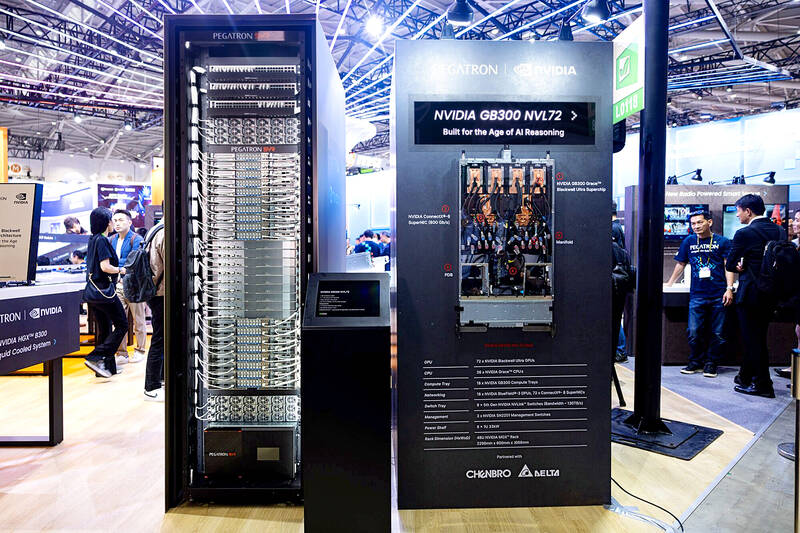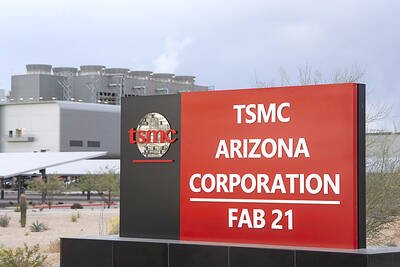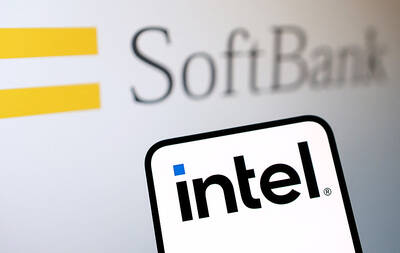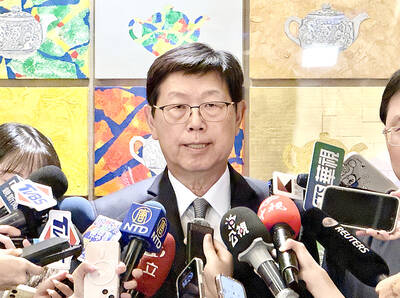Pegatron Corp (和碩) expects triple-digit server revenue growth this quarter from last quarter on the back of strong customer demand, and holds a more optimistic outlook for its server business in the second half of the year than the first, company cochief executive officer Johnson Teng (鄧國彥) said at the Computex trade show in Taipei on Tuesday.
The electronics manufacturer, and one of Apple Inc’s iPhone assemblers, would ship more server samples this quarter and expects annual server revenue to double from last year, Teng said.
Server products based on Nvidia Corp’s GB300 chips are expected to draw attention in the second half of the year and Pegatron is gearing up to grab a share of the market, he said.

Photo: Annabelle Chih, Bloomberg
At Computex, Pegatron is exhibiting its products in four focus areas: high-performance computing, e-mobility and automotive systems, telecommunications and network solutions, and consumer, aesthetic and assisted living applications.
One of its latest products is the RA4802-72N2 rack, a liquid-cooled high-density graphics processing unit (GPU) rack featuring Nvidia’s GB300 NVL72. The rack, equipped with 72 Nvidia Blackwell Ultra GPUs and 36 Grace CPUs, could boost artificial intelligence (AI) output up to 50-fold, with optimized inference performance and an in-house coolant unit to improve thermal efficiency in high-density setups, the company said.
Pegatron would continue working with Nvidia on GB300 solutions to serve existing customers, while also seeking to attract new customers, Pegatron co-CEO Gary Cheng (鄭光志) said.
The company has also identified potential opportunities in Japan and the Middle East, and hopes to achieve some progress in the near term, Cheng said.
Pegatron chairman Tung Tzu-hsien (童子賢) said the rise of AI has helped Taiwan solidify its leading position in the industry, and develop close partnerships with Silicon Valley and US brand customers.
Tung said that this year’s Computex would help the world recognize the importance of hardware manufacturing and reassess the value of Taiwanese suppliers.
“Just as a fence needs three stakes for support, a hero needs allies to succeed,” Tung said, adding that Taiwan can be the most friendly, diligent and proactive partner for the global technology industry amid the AI revolution.
Pegatron’s quadruped robot dog, Simba, is also on display at the company’s booth, with Tung saying that more animal-inspired robots equipped with advanced intelligence, mobility and sensors, such as robot camels, elephants or buffaloes, might one day assist humans with tasks.

Taiwan Semiconductor Manufacturing Co (TSMC, 台積電), the world’s biggest contract chipmaker, booked its first-ever profit from its Arizona subsidiary in the first half of this year, four years after operations began, a company financial statement showed. Wholly owned by TSMC, the Arizona unit contributed NT$4.52 billion (US$150.1 million) in net profit, compared with a loss of NT$4.34 billion a year earlier, the statement showed. The company attributed the turnaround to strong market demand and high factory utilization. The Arizona unit counts Apple Inc, Nvidia Corp and Advanced Micro Devices Inc among its major customers. The firm’s first fab in Arizona began high-volume production

VOTE OF CONFIDENCE: The Japanese company is adding Intel to an investment portfolio that includes artificial intelligence linchpins Nvidia Corp and TSMC Softbank Group Corp agreed to buy US$2 billion of Intel Corp stock, a surprise deal to shore up a struggling US name while boosting its own chip ambitions. The Japanese company, which is adding Intel to an investment portfolio that includes artificial intelligence (AI) linchpins Nvidia Corp and Taiwan Semiconductor Manufacturing Co (TSMC, 台積電), is to pay US$23 a share — a small discount to Intel’s last close. Shares of the US chipmaker, which would issue new stock to Softbank, surged more than 5 percent in after-hours trading. Softbank’s stock fell as much as 5.4 percent on Tuesday in Tokyo, its

COLLABORATION: Softbank would supply manufacturing gear to the factory, and a joint venture would make AI data center equipment, Young Liu said Hon Hai Precision Industry Co (鴻海精密) would operate a US factory owned by Softbank Group Corp, setting up what is in the running to be the first manufacturing site in the Japanese company’s US$500 billion Stargate venture with OpenAI and Oracle Corp. Softbank is acquiring Hon Hai’s electric-vehicle plant in Ohio, but the Taiwanese company would continue to run the complex after turning it into an artificial intelligence (AI) server production plant, Hon Hai chairman Young Liu (劉揚偉) said yesterday. Softbank would supply manufacturing gear to the factory, and a joint venture between the two companies would make AI data

The Taiwan Automation Intelligence and Robot Show, which is to be held from Wednesday to Saturday at the Taipei Nangang Exhibition Center, would showcase the latest in artificial intelligence (AI)-driven robotics and automation technologies, the organizer said yesterday. The event would highlight applications in smart manufacturing, as well as information and communications technology, the Taiwan Automation Intelligence and Robotics Association said. More than 1,000 companies are to display innovations in semiconductors, electromechanics, industrial automation and intelligent manufacturing, it said in a news release. Visitors can explore automated guided vehicles, 3D machine vision systems and AI-powered applications at the show, along